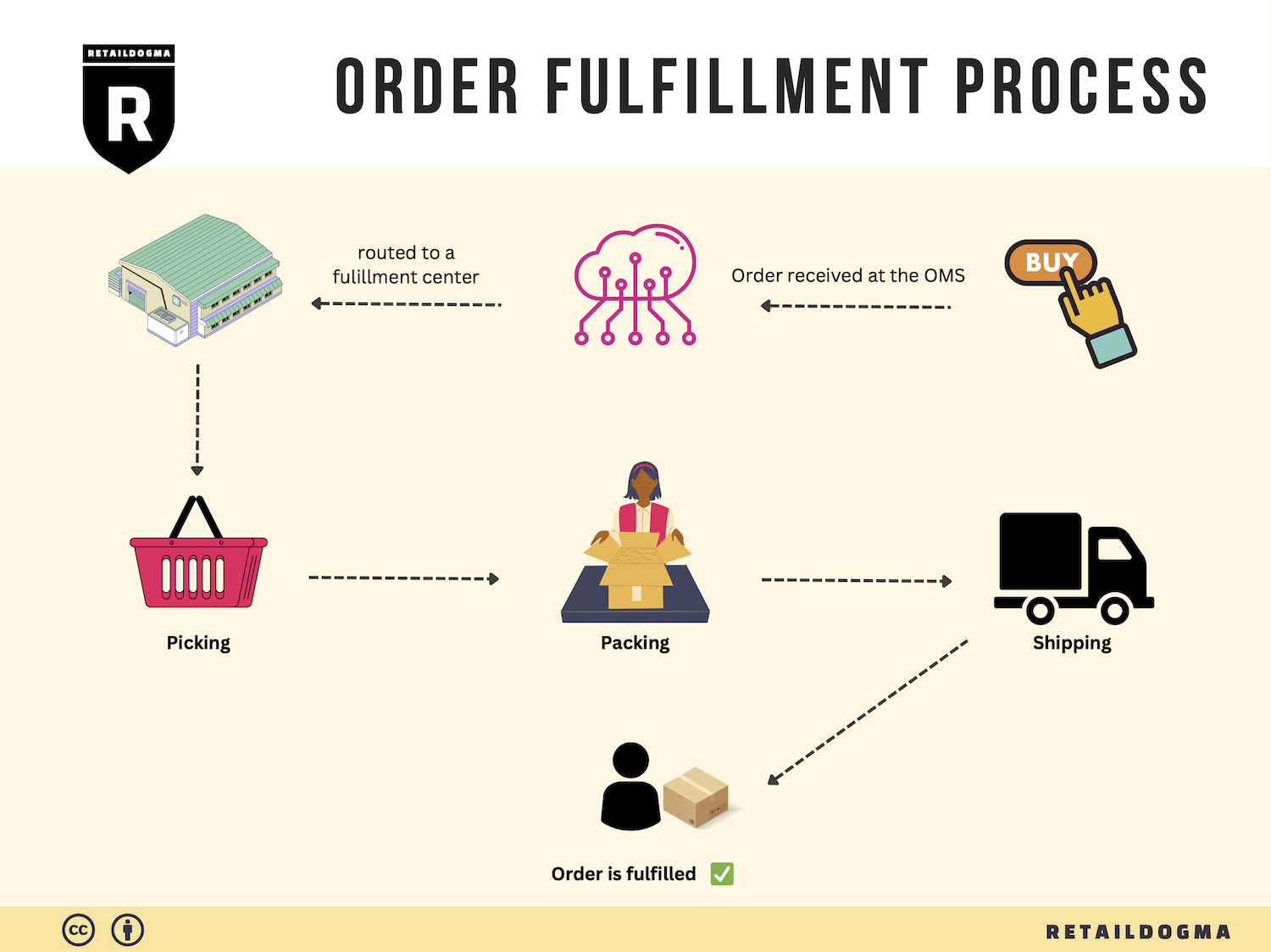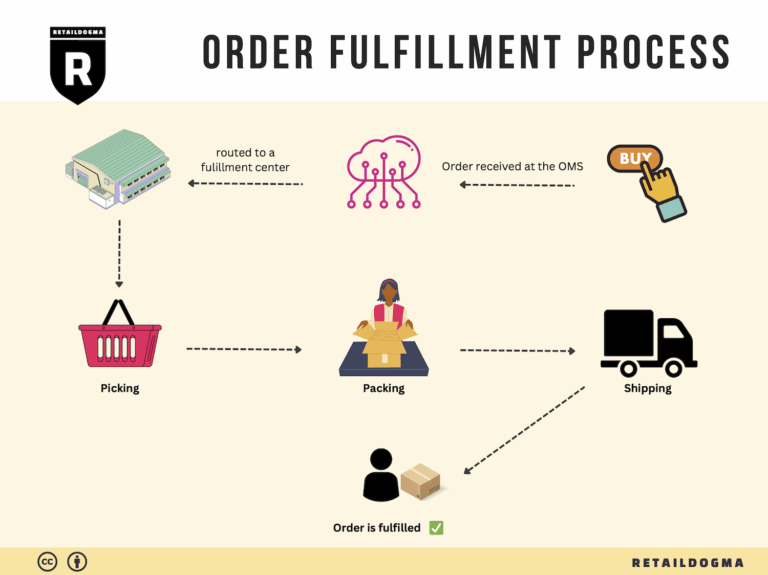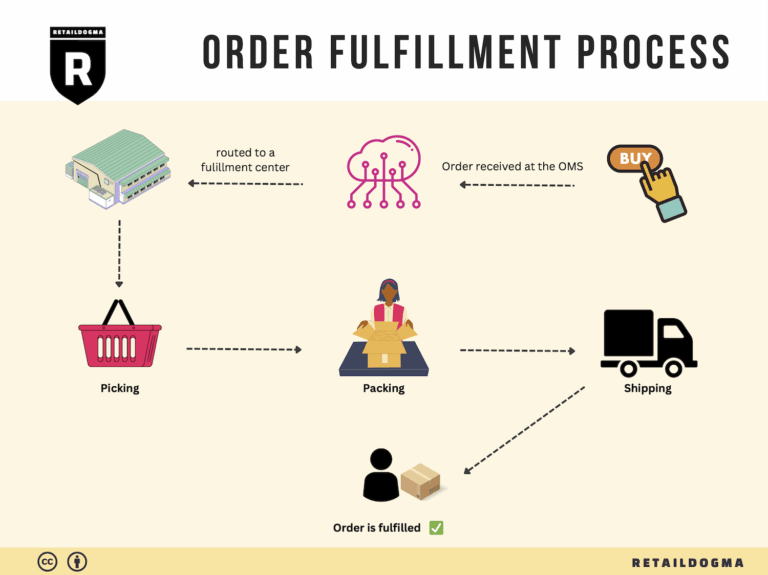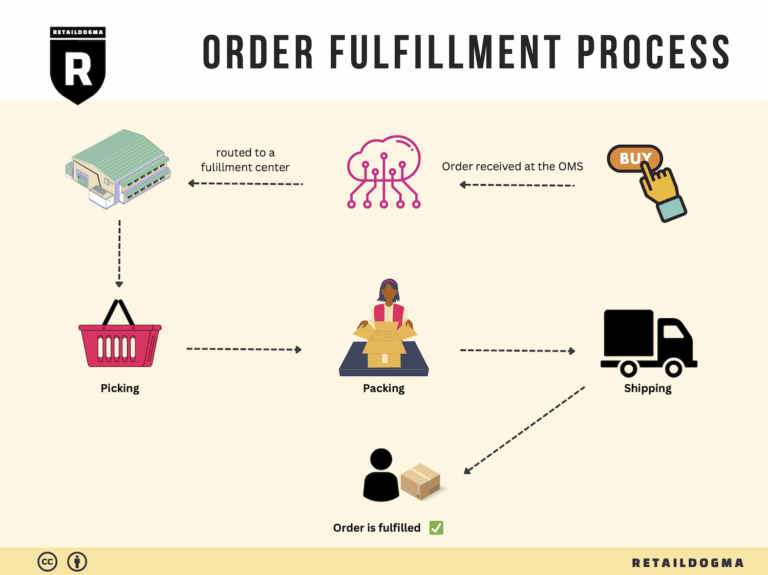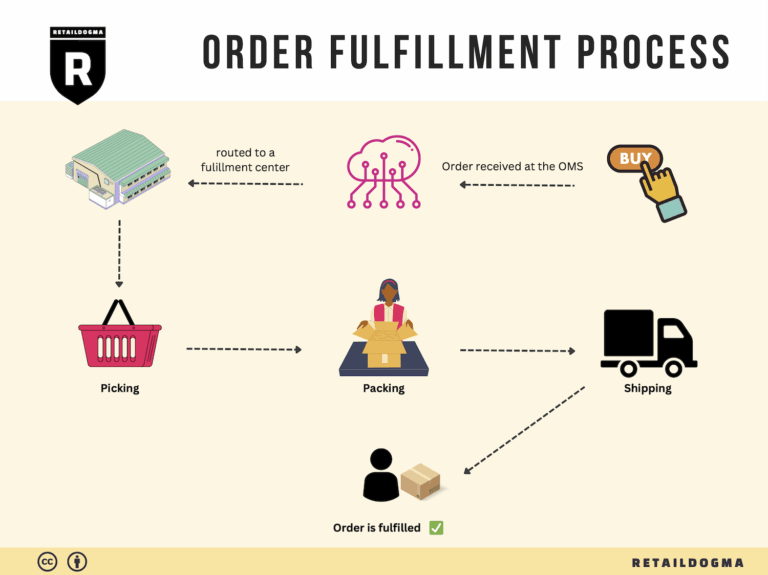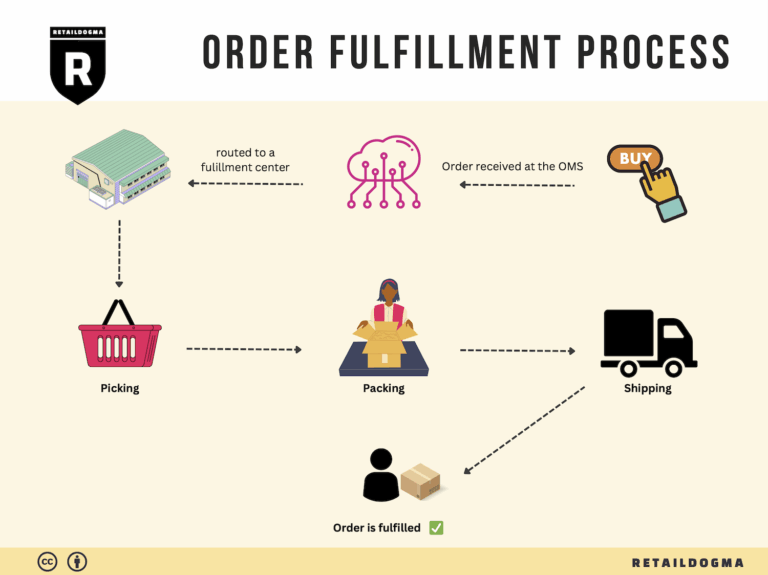Ecommerce Fulfillment Services: The Ultimate Guide (2025)
What is E-commerce Fulfillment? An Introduction for Growing Businesses
Understanding the Challenges of Order Fulfillment
As an e-commerce business owner, you may find yourself overwhelmed by the demands of packing and shipping orders, particularly as your sales begin to scale. The complexities of managing inventory, processing orders, and ensuring timely delivery can quickly escalate into a logistical nightmare. These challenges can detract from your core focus—growing your business and delighting your customers.
What is Fulfillment?
At its essence, fulfillment is the process of getting a product from your warehouse or fulfillment center to your customer’s doorstep. This seemingly straightforward definition encompasses a myriad of tasks, including inventory management, order processing, packing, shipping, and handling returns. As your business grows, the efficiency and effectiveness of your fulfillment strategy become paramount to your success.
What This Guide Covers
This guide aims to demystify e-commerce fulfillment by exploring various fulfillment models, including Third-Party Logistics (3PL) and Fulfillment by Amazon (FBA). Each model has its unique advantages and challenges, and understanding these can help you determine which aligns best with your business goals.
We will delve into the core services provided by fulfillment partners, such as inventory storage, picking and packing, shipping, and customer service. These services are critical for maintaining customer satisfaction and operational efficiency. Additionally, we will provide practical advice on how to choose the right fulfillment partner for your specific needs. Key considerations include assessing their technology capabilities, service levels, geographic coverage, and experience in your industry.
Pricing can often be a sticking point for growing businesses, so we will also discuss how fulfillment costs are structured and what factors influence pricing. Understanding these elements will help you make informed decisions and avoid hidden fees that can eat into your margins.

Empowering Smart Logistics Decisions
The ultimate goal of this guide is to empower you with the knowledge and insights needed to make informed decisions about your logistics strategy. By understanding the various facets of e-commerce fulfillment, you can streamline your operations, enhance customer experiences, and ultimately drive growth in your business. Let’s embark on this journey to optimize your fulfillment processes and set your business up for success in the competitive e-commerce landscape.
What You’ll Learn In This Guide
- What is E-commerce Fulfillment? An Introduction for Growing Businesses
- The Order Fulfillment Process: From ‘Buy’ Button to Customer’s Door
- Comparing Fulfillment Models: In-House vs. 3PL vs. Dropshipping
- A Deep Dive into Amazon FBA: Pros, Cons, and Who It’s For
- Core Services Offered by Fulfillment Centers
- How to Choose a Fulfillment Partner: A 6-Point Checklist
- Understanding Fulfillment Pricing: A Breakdown of Common Fees
- Frequently Asked Questions (FAQs) about Fulfillment
- Conclusion: Is Outsourcing Fulfillment the Right Move for Your Business?
- Important Disclaimer
The Order Fulfillment Process: From ‘Buy’ Button to Customer’s Door
1. Receiving Inventory
The order fulfillment process begins with receiving inventory at the micro fulfillment center (MFC). This step involves checking incoming shipments against purchase orders to ensure that the correct items and quantities have been delivered. Each product is assigned a Stock Keeping Unit (SKU), which serves as a unique identifier for inventory management.
Importance: Proper inventory receipt is crucial for maintaining accurate stock levels and ensuring that items are available for order fulfillment. Inaccuracies at this stage can lead to stockouts or excess inventory, both of which can negatively impact customer satisfaction and profitability.
Key Term: SKU (Stock Keeping Unit) – A unique code used to identify products, facilitating tracking and inventory management.
2. Warehouse Storage
Once the inventory is received and verified, it is stored in the MFC. Effective warehouse storage involves organizing products in a manner that maximizes space and accessibility. This may include categorizing items by type, size, or sales velocity. Utilizing advanced inventory management systems can help automate this process, ensuring that products are easily retrievable.
Importance: Efficient storage not only optimizes space but also reduces the time required to locate and pick items for orders. This is especially vital in a micro fulfillment context, where rapid delivery is a competitive advantage.
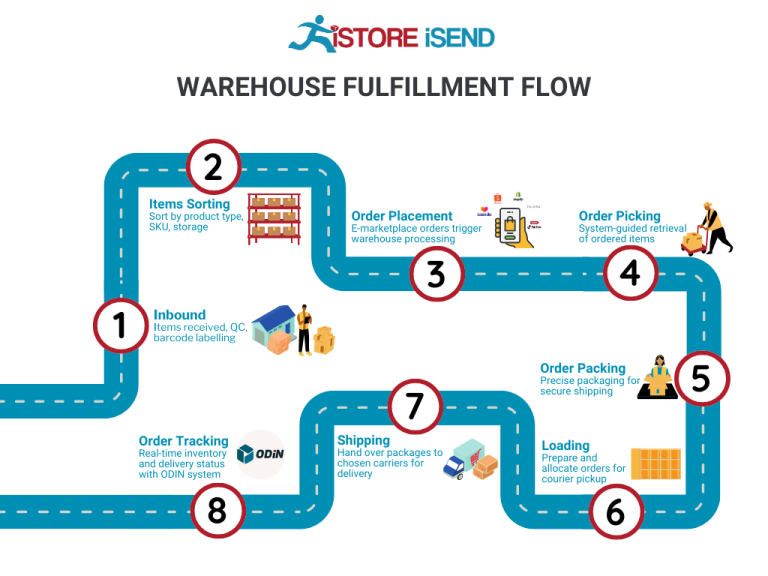
Key Term: FIFO (First In, First Out) – An inventory management method that ensures older stock is sold before newer stock, minimizing waste and obsolescence.
3. Order Picking
Order picking is the process of selecting items from the warehouse to fulfill a customer order. This step can involve various methods, including single order picking, batch picking, or wave picking, depending on the volume of orders and the layout of the MFC. A pick list, which outlines the items and quantities needed for each order, guides this process.
Importance: The accuracy and speed of order picking directly impact customer satisfaction. Errors in this stage can lead to incorrect shipments, which can result in returns, increased operational costs, and diminished customer trust.
Key Term: Pick List – A document or digital tool that outlines the specific items to be retrieved for each order, streamlining the picking process.
4. Order Packing
After items are picked, they move to the packing stage. This involves carefully packaging products for shipment to ensure they arrive at the customer’s doorstep in excellent condition. Effective packing includes selecting appropriate box sizes, using protective materials, and labeling packages accurately. This step may also involve integrating promotional materials or return instructions to enhance the customer experience.
Importance: Proper packing is essential for reducing damage during transit and ensuring that the customer receives the correct items. It also plays a role in branding, as well-packed orders can enhance the perceived value of the product and the overall customer experience.
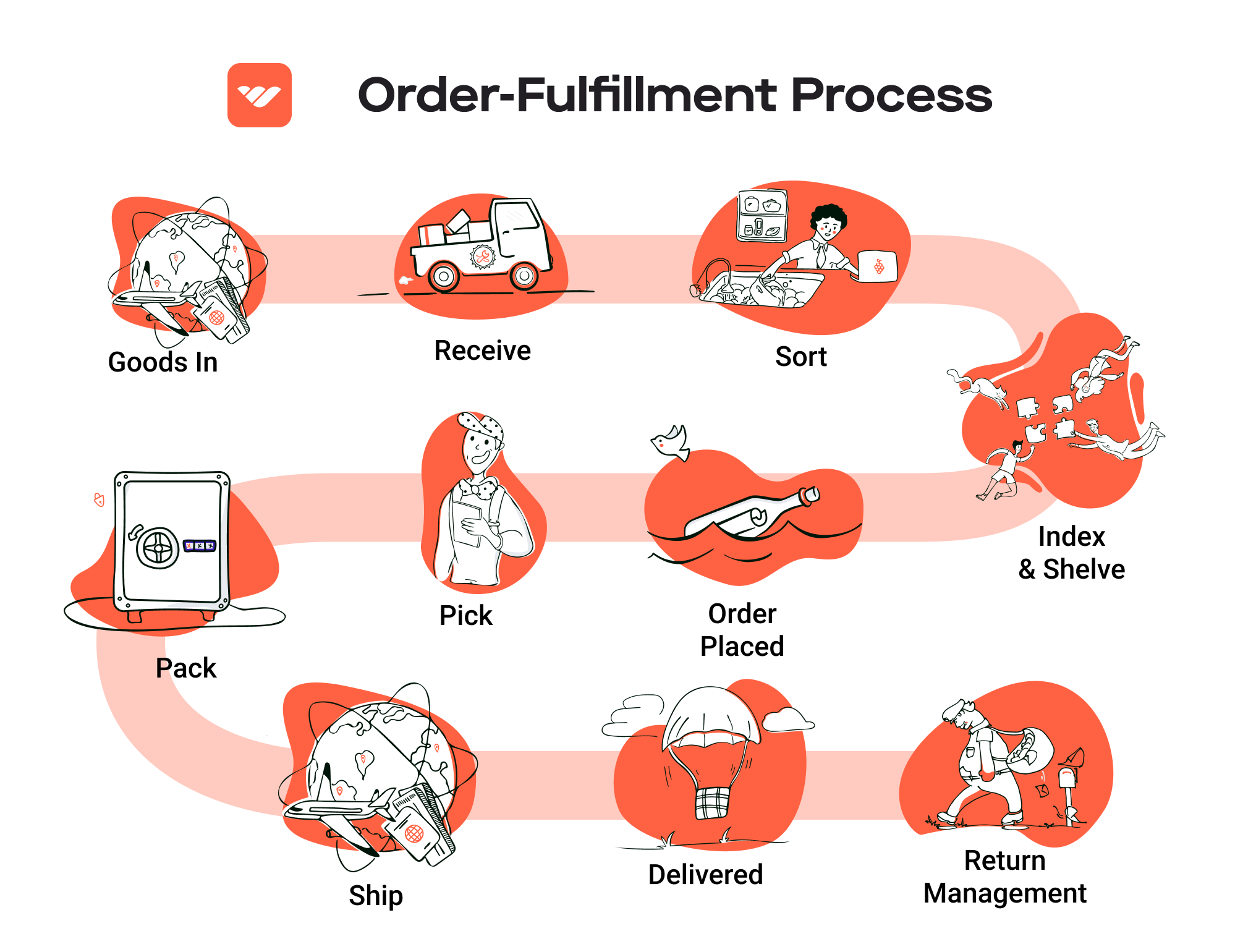
Key Term: Packing Slip – A document included in the package that lists the items enclosed, serving as a confirmation of the order and assisting with returns.
5. Shipping & Delivery
The final step in the order fulfillment process is shipping and delivery. This involves selecting the most efficient shipping method based on factors such as cost, delivery speed, and customer preferences. Leveraging a network of last-mile carriers, MFCs can often offer same-day or next-day delivery services, which are increasingly expected by consumers.
Importance: The speed and reliability of shipping directly influence customer satisfaction and repeat business. In today’s e-commerce landscape, where consumers demand rapid fulfillment, having a robust shipping strategy is critical for success.
Key Term: Last-Mile Delivery – The final step in the shipping process where the package is delivered from a transportation hub to the final destination, often the most complex and costly segment of the delivery process.
By understanding and optimizing each of these five steps in the order fulfillment process, e-commerce businesses can enhance operational efficiency, reduce costs, and improve customer satisfaction. Adopting a micro fulfillment strategy, like that offered by Davinci Micro Fulfillment, can further streamline these processes, allowing businesses to meet the demands of modern consumers effectively.
Comparing Fulfillment Models: In-House vs. 3PL vs. Dropshipping
Fulfillment Model Comparison
| Model | Who Handles Inventory | Best For (Business Stage) | Key Advantage | Key Disadvantage |
|---|---|---|---|---|
| In-House Fulfillment | The business itself | Established businesses with stable demand | Complete control over inventory and processes | High overhead costs and resource allocation |
| Third-Party Logistics (3PL) | A third-party provider | Growing businesses looking to scale | Reduced operational burden and expertise access | Less control over inventory management |
| Dropshipping | Supplier or manufacturer | Startups and low-capital businesses | Low startup costs and minimal risk | Lower profit margins and reliance on suppliers |
In-House Fulfillment
In-house fulfillment refers to the process where a business manages its inventory, warehousing, and shipping operations internally. This model is often favored by established businesses with a steady demand and well-defined processes. The primary advantage of in-house fulfillment is the level of control it offers. Businesses can oversee every aspect of the supply chain, from inventory management to order processing, ensuring that their standards are met consistently. Additionally, having direct access to inventory allows for quicker response times to customer orders, which can enhance customer satisfaction. However, this model comes with significant drawbacks. The overhead costs are high, as businesses must invest in warehousing, technology, staffing, and logistics. This can strain resources, especially for businesses that may experience fluctuations in demand. Furthermore, managing fulfillment operations requires expertise in logistics, which can divert focus from core business activities.
Third-Party Logistics (3PL)
Third-party logistics (3PL) involves outsourcing fulfillment operations to a specialized provider. This model is particularly beneficial for growing businesses looking to scale their operations without the burden of managing logistics themselves. By partnering with a 3PL provider, businesses can leverage the provider’s expertise, technology, and established networks. This can lead to improved shipping times, cost savings, and a more efficient supply chain. A key advantage of using 3PL is the reduced operational burden; businesses can focus on their core competencies, such as marketing and product development, while leaving logistics to the experts. However, the trade-off is a loss of control over inventory management and fulfillment processes. Businesses may face challenges in ensuring that their standards are upheld, as they rely on a third party to execute their fulfillment strategy. Additionally, if a 3PL provider experiences issues, such as labor shortages or capacity constraints, it can directly impact the business’s ability to serve its customers.
Dropshipping
Dropshipping is a fulfillment model where a business sells products without holding any inventory. Instead, when a customer places an order, the business purchases the item from a third-party supplier, who then ships it directly to the customer. This model is ideal for startups and low-capital businesses, as it requires minimal upfront investment and eliminates the risks associated with unsold inventory. The primary advantage of dropshipping is the low barrier to entry, allowing entrepreneurs to test new products and markets without significant financial commitment. Additionally, businesses can offer a wider range of products without the need for warehousing. However, dropshipping comes with its own set of challenges. Profit margins tend to be lower compared to other fulfillment models, as businesses must pay wholesale prices to suppliers. Moreover, reliance on suppliers can lead to issues with stock availability and shipping times, which can negatively affect customer satisfaction. As businesses scale, they may find it increasingly difficult to maintain quality control and customer service when relying on multiple suppliers.
A Deep Dive into Amazon FBA: Pros, Cons, and Who It’s For
Understanding Fulfillment by Amazon (FBA)
Fulfillment by Amazon (FBA) is a service offered by Amazon that enables e-commerce sellers to store their products in Amazon’s fulfillment centers. Amazon takes care of storage, packaging, shipping, and customer service, allowing sellers to focus on other aspects of their business. When a customer places an order, Amazon picks, packs, and ships the product directly to the customer, while also handling returns and customer inquiries.
How FBA Works
-
Setting Up an FBA Account: Sellers begin by creating an Amazon seller account and enrolling in the FBA program. This includes providing information about their business, products, and payment methods.
-
Product Preparation: Sellers must prepare their products according to Amazon’s specific guidelines. This includes labeling, packaging, and ensuring that items meet Amazon’s quality standards.
-
Shipping Inventory to Amazon: Once products are prepared, sellers ship their inventory to Amazon’s fulfillment centers. Amazon provides shipping plans and guidelines to help sellers understand how to send their products efficiently.
-
Storage and Management: After the products arrive at the fulfillment center, Amazon stores them until a customer places an order. Sellers can manage their inventory levels, monitor sales, and track performance through the Amazon Seller Central dashboard.
-
Order Fulfillment: When a customer orders a product, Amazon takes care of the entire fulfillment process. This includes picking the item from the warehouse, packing it, and shipping it using Amazon’s extensive logistics network.
-
Customer Service and Returns: Amazon also handles customer service inquiries related to FBA orders, including processing returns and refunds. This level of service enhances the customer experience and builds trust in the Amazon marketplace.
Pros of Using Amazon FBA
-
Prime Eligibility: Products fulfilled by Amazon are automatically eligible for Amazon Prime, which attracts millions of loyal Prime members who prefer fast and free shipping options. This can lead to increased sales and visibility.
-
Customer Trust: Utilizing FBA can enhance a seller’s credibility. Customers often trust Amazon’s fulfillment services, knowing that they will receive their orders on time and have access to Amazon’s customer service and return policies.
-
Multi-Channel Fulfillment: FBA isn’t limited to Amazon sales. Sellers can utilize FBA to fulfill orders from other sales channels, such as their own websites or other marketplaces, providing a seamless fulfillment experience.
-
Scalability: FBA allows businesses to scale without the need for significant investments in logistics infrastructure. Sellers can quickly increase their inventory levels and reach a broader audience without the complexities of managing warehousing and shipping.
-
Focus on Growth: With Amazon handling logistics, sellers can concentrate on growing their business, such as enhancing marketing efforts, optimizing product listings, and developing new products.
Cons of Using Amazon FBA
-
High Fees: FBA comes with various fees, including storage fees for holding inventory and fulfillment fees for each order processed. These costs can add up, especially for slow-moving products, affecting overall profitability.
-
Strict Inventory Rules: Amazon has stringent inventory management policies. Sellers must comply with these rules, which include limits on the amount of inventory they can send to fulfillment centers and the requirement to maintain stock levels to avoid long-term storage fees.
-
Commingling Risks: FBA products may be commingled, meaning that inventory from different sellers may be stored together. This can lead to issues if a seller receives negative feedback for a product that is not theirs or if their inventory is mistakenly shipped to customers.
-
Limited Control Over Fulfillment: By relying on Amazon for fulfillment, sellers give up a degree of control over how their products are handled, packaged, and shipped. This could impact brand presentation and customer experience.
-
Dependency on Amazon’s Policies: Sellers must adhere to Amazon’s ever-changing policies and guidelines, which can affect how they operate their business. Any changes in fees, rules, or seller performance metrics can have a direct impact on profitability.
Who is FBA Best For?
Fulfillment by Amazon is best suited for:
-
Small to Medium-Sized E-Commerce Businesses: Companies looking to scale quickly without investing heavily in logistics and fulfillment infrastructure can benefit from the simplicity and efficiency of FBA.
-
Brands with High Turnover Products: Businesses that sell fast-moving consumer goods or seasonal items can leverage FBA to ensure timely delivery and maximize sales during peak periods.
-
Sellers Seeking to Tap into Amazon’s Massive Customer Base: Brands that want to increase visibility and reach Amazon’s vast audience can benefit from FBA, particularly if they want to target Prime members.
-
Multi-Channel Sellers: Businesses that sell across various platforms and want a streamlined fulfillment process can utilize FBA for both Amazon and non-Amazon sales channels.
-
Entrepreneurs Focusing on Growth: For sellers who prefer to concentrate on marketing, product development, and customer engagement rather than logistics, FBA provides a practical solution that allows them to focus on their core business activities.
In conclusion, while Fulfillment by Amazon offers numerous advantages for e-commerce sellers, it is essential to weigh these benefits against the potential drawbacks. Understanding your business model, sales volume, and logistical needs will help determine if FBA is the right fit for your e-commerce strategy.
Core Services Offered by Fulfillment Centers
Inventory Management & Warehousing
Inventory management and warehousing are foundational services provided by fulfillment centers, enabling e-commerce businesses to maintain optimal stock levels and streamline their operations. This service involves the systematic control of inventory, including tracking stock levels, managing reorders, and ensuring that products are stored efficiently.
One of the primary benefits of effective inventory management is the reduction of holding costs. By leveraging advanced inventory tracking systems, fulfillment centers can provide real-time visibility into stock levels, allowing businesses to avoid overstocking or stockouts. This is especially critical in today’s fast-paced e-commerce environment, where consumer demand can fluctuate dramatically.
Furthermore, strategic warehousing locations minimize shipping distances, which can lead to faster delivery times and reduced shipping costs. For e-commerce businesses looking to enhance their customer experience, ensuring that products are readily available and can be shipped promptly is essential. A robust inventory management system also aids in data analysis, helping businesses to forecast demand accurately and make informed purchasing decisions.
Pick and Pack Services
Pick and pack services are critical to the fulfillment process, involving the selection (picking) of items from inventory and preparing (packing) them for shipment. This service is crucial for e-commerce businesses that need to fulfill customer orders accurately and efficiently.
The benefits of pick and pack services are multifaceted. First, they significantly reduce the time required to process orders, allowing businesses to meet customer expectations for quick delivery. With fulfillment centers employing advanced picking technologies and methodologies, such as batch picking and zone picking, the efficiency of order fulfillment is greatly enhanced.
Additionally, professional packing ensures that products are shipped securely, minimizing the risk of damage during transit. This not only protects the merchandise but also enhances customer satisfaction, as well-packaged items contribute to a positive unboxing experience. By outsourcing pick and pack services to a fulfillment center, e-commerce businesses can focus on their core competencies, such as marketing and product development, rather than the intricacies of order processing.
Kitting and Assembly
Kitting and assembly services involve the grouping of individual items into ready-to-ship sets or kits, which can include everything from promotional bundles to complete product assemblies. This service is particularly beneficial for e-commerce businesses that offer customizable products or promotional items.
The primary advantage of kitting and assembly services is the ability to provide customers with unique offerings that enhance their shopping experience. For instance, businesses can create themed bundles or seasonal kits that not only attract attention but also increase average order value. By offering curated selections, e-commerce brands can differentiate themselves in a crowded marketplace.
Moreover, kitting can streamline the fulfillment process. By assembling products into kits before orders are received, fulfillment centers can reduce the time needed for order processing. This proactive approach not only enhances operational efficiency but also allows for quicker delivery times, catering to the growing consumer expectation for rapid fulfillment.
Returns Management (Reverse Logistics)
Returns management, or reverse logistics, is a crucial service offered by fulfillment centers that deals with the processing of returned items. This service includes everything from handling customer returns to restocking items and managing defective products.
Effective returns management is vital for maintaining customer satisfaction and loyalty. By providing a seamless returns process, e-commerce businesses can foster trust and encourage repeat purchases. Fulfillment centers often employ technology to automate returns processing, making it easier for businesses to track and manage returns efficiently.
Additionally, a well-structured returns management system can provide valuable insights into customer preferences and product quality. Understanding the reasons behind returns can help businesses identify areas for improvement in their product offerings or customer service. Moreover, efficient reverse logistics can minimize losses associated with returned items by facilitating timely restocking or refurbishment of products, ultimately enhancing profitability.
In conclusion, the core services offered by fulfillment centers—inventory management and warehousing, pick and pack services, kitting and assembly, and returns management—are essential for e-commerce businesses seeking to scale their operations effectively. By leveraging these services, businesses can enhance efficiency, reduce costs, and improve customer satisfaction, positioning themselves for sustainable growth in the competitive e-commerce landscape.
How to Choose a Fulfillment Partner: A 6-Point Checklist
Location & Warehouse Network
Importance:
The geographical location of your fulfillment partner’s warehouses directly impacts shipping times and costs. A partner with a strategically located warehouse network can facilitate faster deliveries to your customers, enhancing their experience and potentially increasing repeat business.
Questions to Ask:
– How many fulfillment centers do you operate, and where are they located?
– What is the average delivery time to key customer locations from your warehouses?
– Do you have the capability to expand your warehouse network if my business grows?
Technology & Integrations
Importance:
In today’s e-commerce landscape, technology plays a pivotal role in streamlining operations. A fulfillment partner should offer robust technology solutions, including inventory management systems and order tracking capabilities. Seamless integration with your existing platforms (like e-commerce websites and marketplaces) can significantly enhance efficiency and customer satisfaction.
Questions to Ask:
– What technology solutions do you provide for order management and inventory tracking?
– Can your system integrate with my existing e-commerce platform and other tools I use?
– Do you offer real-time tracking and reporting features for orders?
Specializations (e.g., cold storage, oversized items)
Importance:
Different products require different handling and storage solutions. If you sell perishable goods, for instance, you’ll need a partner that offers cold storage. If your products are large or require special handling, ensure your fulfillment partner has the necessary capabilities to manage those items effectively.
Questions to Ask:
– Do you have specialized facilities for handling specific types of products, such as perishables or oversized items?
– What protocols do you have in place for managing inventory that requires special handling?
– Can you provide case studies or references from similar businesses that you have serviced?
Scalability & Capacity
Importance:
As your business grows, your fulfillment needs will evolve. A partner that can easily scale up or down based on your sales volume ensures that you can meet customer demand without incurring unnecessary costs during slower periods. Look for a partner with flexible capacity and resources.
Questions to Ask:
– How do you manage fluctuating order volumes during peak seasons?
– What is your capacity for scaling operations, and how quickly can you adapt to increased demand?
– Do you have contingency plans in place to handle unexpected surges in order volume?
Pricing and Contracts
Importance:
Understanding the pricing structure and contract terms of your fulfillment partner is crucial for maintaining profitability. Look for transparency in pricing and ensure that you are not facing hidden fees. A clear understanding of contract terms can also prevent future disputes.
Questions to Ask:
– Can you provide a detailed breakdown of your pricing model, including any additional fees?
– Are there minimum order requirements or penalties for low order volumes?
– What are the terms regarding contract length, termination, and any penalties for early termination?
Customer Support & Reviews
Importance:
Exceptional customer support can make a significant difference in your fulfillment operations. A partner that is responsive and proactive can help resolve issues quickly and efficiently. Additionally, reviews and testimonials from other clients can provide insight into their reliability and service quality.
Questions to Ask:
– What type of customer support do you offer (e.g., dedicated account manager, 24/7 support)?
– Can you share references or testimonials from current or past clients?
– How do you handle issues or complaints that arise during the fulfillment process?
Conclusion
Choosing the right fulfillment partner is a critical decision that can significantly affect your e-commerce business’s efficiency, customer satisfaction, and overall success. By using this checklist, you can ensure that you are asking the right questions and evaluating potential partners based on the most important criteria. Remember, a strategic partnership in fulfillment can provide a competitive edge and support your growth in the ever-evolving e-commerce landscape.
Understanding Fulfillment Pricing: A Breakdown of Common Fees
Initial Setup Fees
Initial setup fees are often the first costs incurred when partnering with a micro fulfillment service like Davinci Micro Fulfillment. These fees cover the onboarding process, which includes account setup, integration with your e-commerce platform, and any necessary training for your team. Depending on the complexity of your inventory and the systems in place, initial setup fees can vary significantly. Typically, these fees may be a one-time charge ranging from a few hundred to several thousand dollars.
To calculate these fees, providers often consider the following factors:
– The size of your inventory and the number of SKUs (Stock Keeping Units) to be integrated.
– The level of customization required for your software integration.
– The training requirements for your staff to effectively use the new systems.
Understanding these initial costs is crucial, as they set the foundation for your ongoing fulfillment expenses.
Receiving Fees
Receiving fees are charged for the process of accepting and inspecting inventory as it arrives at the fulfillment center. This fee can include unloading, checking for damages, and entering the products into the inventory management system.
These fees are generally calculated based on:
– The volume of inventory received, often measured in pallets or individual items.
– The labor costs associated with the receiving process, which may vary depending on the complexity and speed required.
For businesses, it’s important to ask about the specifics of receiving fees, as they can add up, especially for brands that frequently replenish their stock.
Storage Fees (per pallet/bin)
Storage fees are charged for the space your inventory occupies within the fulfillment center. These fees can be assessed on a per-pallet or per-bin basis and are typically billed monthly.
Calculating storage fees involves:
– The total amount of inventory stored, often measured in pallets or cubic feet.
– The duration that inventory remains in the warehouse, as longer storage times may incur higher fees.
Storage fees can impact cash flow, especially for businesses with seasonal inventory fluctuations. Therefore, it’s vital to evaluate your inventory turnover rate to estimate potential storage costs accurately.
Pick & Pack Fees (per item/order)
Pick and pack fees are among the most significant costs in fulfillment pricing. This fee covers the labor involved in picking items from inventory and packing them for shipment. The pricing is typically calculated on a per-item or per-order basis, depending on the fulfillment provider’s structure.
Factors influencing pick and pack fees include:
– The number of items in each order; more items generally lead to higher fees.
– The complexity of the packing process, including special packaging or kitting requirements.
– Any additional services, such as labeling or custom packaging.
For e-commerce businesses, understanding this fee structure is critical, as it directly affects profit margins and pricing strategies.
Shipping Fees
Shipping fees encompass the costs associated with transporting orders from the fulfillment center to the end customer. These fees can vary widely based on shipping methods, distances, and carrier rates.
Key components of shipping fees include:
– The weight and dimensions of the package, which impact carrier pricing.
– The chosen shipping speed (e.g., same-day, next-day, standard).
– Any additional surcharges for rural or remote deliveries.
E-commerce businesses should consider negotiating shipping rates with fulfillment providers or exploring partnerships with multiple carriers to optimize shipping costs.
Tips for Getting an Accurate Quote
To ensure you receive an accurate fulfillment pricing quote, consider the following tips:
-
Provide Detailed Information: Share specifics about your inventory, including the number of SKUs, average order volume, and any unique fulfillment requirements.
-
Ask About All Fees: Inquire about all potential fees, including hidden costs that may not be immediately apparent, such as returns processing or special handling fees.
-
Request a Breakdown: Ask for a detailed breakdown of each fee type to understand how they contribute to the overall cost structure.
-
Evaluate Volume Discounts: Discuss options for volume discounts based on your projected order volume, as many fulfillment centers offer tiered pricing.
-
Review Contract Terms: Carefully read through any contracts or agreements to ensure there are no unfavorable terms related to pricing or service levels.
By following these guidelines, e-commerce business owners can better navigate the complexities of fulfillment pricing and make informed decisions that support their scaling efforts.
Frequently Asked Questions (FAQs) about Fulfillment
1. What is Davinci Micro Fulfillment?
Davinci Micro Fulfillment is a service designed to streamline e-commerce operations by utilizing micro fulfillment centers (MFCs) located near urban areas. This approach enables brands and retailers to fulfill orders quickly, often within one to two days, by leveraging advanced technology and strategically placed inventory. The goal is to provide a seamless shopping experience for customers, meeting their demand for speed and efficiency.
2. How does micro fulfillment differ from traditional fulfillment?
Micro fulfillment focuses on smaller, strategically located fulfillment centers that enable faster delivery times—often same-day or next-day—compared to traditional fulfillment centers, which may be larger and located farther from customers. This proximity reduces shipping distances and lead times, allowing businesses to respond more rapidly to consumer demand.
3. What is a fulfillment center?
A fulfillment center is a specialized warehouse that focuses on receiving, processing, and delivering orders directly to customers. Unlike traditional warehouses, which may store inventory for long periods, fulfillment centers emphasize quick turnaround and efficient shipping to optimize the order fulfillment process.
4. What is a 3PL (Third-Party Logistics)?
A 3PL, or third-party logistics provider, is a company that offers outsourced logistics services, including warehousing, fulfillment, and transportation. Businesses partner with 3PLs to leverage their expertise and infrastructure, allowing them to focus on core competencies while ensuring efficient order processing and delivery.
5. How much do fulfillment services cost?
The cost of fulfillment services can vary based on several factors, including order volume, storage needs, shipping methods, and specific service requirements. Businesses should expect to pay for storage fees, picking and packing costs, and shipping charges. It’s essential to evaluate the pricing structure of providers like Davinci Micro Fulfillment to understand how their services align with your budget and operational needs.
6. How does Davinci Micro Fulfillment ensure fast delivery?
Davinci Micro Fulfillment achieves rapid delivery through its network of micro fulfillment centers strategically located within a 90-mile radius of urban areas. This allows for efficient last-mile delivery options, often enabling same-day or next-day service, thus enhancing customer satisfaction and loyalty.
7. What technology does Davinci use for fulfillment?
Davinci Micro Fulfillment employs advanced technology for inventory management, order processing, and tracking. Their systems provide real-time visibility into stock levels, order status, and shipping progress, allowing businesses to make informed decisions and optimize their supply chain operations.
8. Can Davinci Micro Fulfillment support multiple sales channels?
Yes, Davinci Micro Fulfillment is designed to support a variety of sales channels, including direct-to-consumer (DTC), wholesale, and marketplace sales (such as Amazon and Walmart). This flexibility enables brands to manage their inventory and fulfill orders efficiently across different platforms, maximizing reach and sales potential.
9. How does Davinci handle inventory management?
Davinci Micro Fulfillment uses sophisticated inventory management systems that optimize stock levels based on demand forecasting and sales data. This proactive approach helps prevent stockouts, reduces excess inventory, and ensures that the right products are available when customers need them.
10. What are the sustainability practices of Davinci Micro Fulfillment?
Davinci Micro Fulfillment is committed to sustainability by consolidating parcel volumes and optimizing delivery routes to reduce shipping distances. This not only enhances delivery speed but also minimizes the carbon footprint associated with logistics. By partnering with various delivery services, they aim to improve overall efficiency and contribute to environmentally friendly practices in e-commerce fulfillment.
Conclusion: Is Outsourcing Fulfillment the Right Move for Your Business?
Unlocking Growth through Outsourced Fulfillment
Outsourcing fulfillment can be a transformative decision for e-commerce businesses seeking to scale efficiently. By leveraging a fulfillment service, you can save valuable time, allowing your team to focus on core activities such as marketing, product development, and customer engagement. The intricacies of managing inventory, shipping logistics, and order processing can be daunting. A specialized partner alleviates these burdens, ensuring that your operations run smoothly and efficiently.
Scalability is another significant advantage of outsourcing fulfillment. As your business grows, so does the complexity of your logistics. A fulfillment partner provides the flexibility to scale operations up or down based on demand fluctuations, seasonal spikes, or market changes. This adaptability ensures that you can meet customer expectations for fast delivery without compromising on service quality or incurring unnecessary costs.
Moreover, a dedicated fulfillment service brings expertise that can enhance your overall logistics strategy. With a deep understanding of the e-commerce landscape, a proficient partner can optimize your supply chain, reduce lead times, and improve inventory management, ultimately leading to increased customer satisfaction and loyalty.
However, it’s crucial to choose the right fulfillment partner. Evaluate potential providers based on their technology capabilities, geographic reach, and alignment with your business goals. A well-chosen partner can drive your growth trajectory, while a misaligned one may hinder your progress.
Take Action
Consider auditing your current shipping and fulfillment processes. Are they streamlined, efficient, and able to support your growth ambitions? If you find gaps or inefficiencies, it may be time to explore outsourced fulfillment options. By assessing your logistics strategy today, you can position your business for success tomorrow.
Important Disclaimer
⚠️ Important Disclaimer
The information in this guide is for educational purposes. Fulfillment services, pricing, and platform features change frequently. Always conduct your own due diligence and consult with providers directly before making business decisions.
